List of indigenous peoples
This is a partial list of the world's indigenous / aboriginal / native people. Indigenous peoples are any ethnic group of peoples who are considered to fall under one of the internationally recognized definitions of Indigenous peoples, such as United Nations, the International Labour Organization and the World Bank, i.e. "those ethnic groups that were indigenous to a territory prior to being incorporated into a national state, and who are politically and culturally separate from the majority ethnic identity of the state that they are a part of".[1]
This list is grouped by region, and sub-region. Note that a particular group may warrant listing under more than one region, either because the group is distributed in more than one region (example: Inuit in North America and eastern Russia), or there may be some overlap of the regions themselves (that is, the boundaries of each region are not always clear, and some locations may commonly be associated with more than one region).
Contents
1 Definition
2 Africa
2.1 African Great Lakes
2.2 Central Africa
2.3 Horn of Africa
2.4 Maghreb
2.5 Nile Valley
2.6 Southwestern Africa
2.7 Southeastern Africa
2.8 West Africa
3 Eurasia
3.1 Asia
3.1.1 Southwest Asia (Middle East)
3.1.2 Caucasus
3.1.3 Eurasian Steppe
3.1.4 South Asia
3.1.5 Southeast Asia
3.1.5.1 Mainland Southeast Asia (Indochina)
3.1.5.2 Maritime Southeast Asia (Indonesia)
3.1.6 East Asia
3.1.6.1 North China
3.1.6.2 South China
3.1.6.3 Taiwan
3.1.6.4 Japan
3.1.7 Siberia
3.2 Europe
3.2.1 Eastern Europe
3.2.2 Northern and western Europe
4 Oceania
4.1 Australia
4.1.1 North
4.1.2 Arnhem
4.1.3 Desert
4.1.4 Torres Strait
4.1.5 Rainforest
4.1.6 Tasmania
4.2 Melanesia
4.3 Micronesia
4.4 Polynesia
5 The Americas
5.1 North America
5.1.1 Arctic
5.1.2 Subarctic
5.1.3 Pacific Northwest Coast
5.1.4 Northwest Plateau-Great Basin-California
5.1.4.1 Northwest Plateau
5.1.4.2 Great Basin
5.1.4.3 California
5.1.5 Great Plains
5.1.6 Eastern Woodlands
5.1.6.1 Northeastern Woodlands
5.1.6.2 Southeastern Woodlands
5.1.7 Southwest
5.1.8 Mesoamerica
5.1.9 Circum-Caribbean
5.1.10 Caribbean
5.2 South America
5.2.1 Circum-Caribbean (Chibcha)
5.2.2 Amazon
5.2.2.1 Guianas
5.2.3 Eastern Highlands (Brazilian Highlands)
5.2.4 Chaco
5.2.5 Andes
5.2.6 Southern Cone
5.2.6.1 Araucania
5.2.6.2 Patagonia
5.2.6.3 Fire Land (Tierra del Fuego)
6 Circumpolar
7 See also
8 Notes
9 References
Definition
Indigenous communities, peoples and nations are those which, having a historical continuity with pre-invasion and pre-colonial societies that developed on their territories, consider themselves distinct from other sectors of the societies now prevailing on those territories, or parts of them. They form at present non-dominant sectors of society and are determined to preserve, develop and transmit to future generations their ancestral territories, and their ethnic identity, as the basis of their continued existence as peoples, in accordance with their own cultural patterns, social institutions and legal system.[2]
This historical continuity may consist of the continuation, for an extended period reaching into the present of one or more of the following factors:
- Occupation of ancestral lands, or at least of part of them
- Common ancestry with the original occupants of these lands
- Culture in general, or in specific manifestations (such as religion, living under a tribal system, membership of an indigenous community, dress, means of livelihood, lifestyle, etc.)
- Language (whether used as the only language, as mother-tongue, as the habitual means of communication at home or in the family, or as the main, preferred, habitual, general or normal language)
- Residence in certain parts of the country, or in certain regions of the world
- Other relevant factors.
- On an individual basis, an indigenous person is one who belongs to these indigenous populations through self-identification as indigenous (group consciousness) and is recognized and accepted by these populations as one of its members (acceptance by the group). This preserves for these communities the sovereign right and power to decide who belongs to them, without external interference.[3]
Africa
African Great Lakes
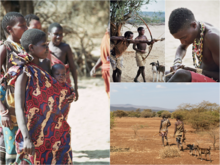
Hadza people, who are indigenous to the African Great Lakes
Hadza (Hadzabe): Tanzania, Singida region: southeast, south and northwest of Lake Eyashi.
Sandawe: Tanzania, Dodoma region: Kondoa district, between Bubu and Mponde rivers, Singida region.
Pygmy peoples:
Twa
Bangweulu Twa: Northern Zambia, Bangweulu Swamps,
Great Lakes Twa: Rwanda, Burundi, Uganda, Democratic Republic of Congo
Kafwe Twa: Southern Zambia, Kafue Flats
Lukanga Twa: Central Zambia, Lukanga Swamp
Nsua: Western Uganda

A Maasai traditional dance.
Nilo-Saharan speakers
Kalenjin: Kenya
Maasai: Kenya, Tanzania
Samburu: Kenya, Tanzania
Bantu peoples
Kikuyu: Kenya
Luhya: Kenya
Bukusu: Kenya, Uganda
Afroasiatic speakers
Iraqw: Tanzania
Rendille: Kenya
Central Africa

Baka pygmy dancers in the East Province of Cameroon.

Batwa Pygmy with traditional bow and arrow
Pygmy peoples:
Bedzan: Northern Central Cameroon
Mbenga:
Aka (Bayaka)
Baka (Bebayaka): Cameroon, Congo (Brazzaville), Gabon, and Central African Republic
Bongo (Babongo):
Gyele (Bagyele):
Kola (Bakola):
Mbuti (Bambuti):
Asua: Democratic Republic of the Congo
Efé: Democratic Republic of the Congo
Kango/Sua:
Mbuti:
Wochua:
Twa
Angola Twa: Northeastern, Eastern and Southern Angola
Kasai Twa/Kuba Twa: Central Democratic Republic of Congo
Mbote Twa: Southeastern Democratic Republic of Congo, Northwest of Lake Tanganyika
Mongo Twa/Ntomba Twa: Western Democratic Republic of Congo, Lake Tumba, Lake Mai-Ndombe
Upemba Twa/Luba Twa: Southeastern Democratic Republic of Congo, Upemba Depression
Horn of Africa

Somali women in traditional headresses

Tigrayan women in traditional attire

Wolayta chief

Berta people playing trumpets during a wedding ceremony
Afroasiatic speakers
Cushitic speakers
Lowland East Cushitic speakers- Oromo
Saho-Afar speakers
Afar (Qafár/'Afár): Northeastern Ethiopia, Afar Region
Saho (Saho): Central Eritrea, Southern part of Northern Red Sea Region
Somalis: Somalia, Djibouti, eastern Ethiopia, northeastern Kenya
Highland East Cushitic speakers
Burji: Southern Ethiopia, Southern Nations, Nationalities, and Peoples Region (SNNPR)
Gedeo (Gedeo): Southern Ethiopia, Southern Nations, Nationalities, and Peoples Region (SNNPR)
Sidama (Sidaama): Southern Ethiopia, Southern Nations, Nationalities, and Peoples Region (SNNPR)
Semitic speakers
South Semitic speakers- Amhara
- Beta Israel
- Tigrayans
- Tigre
Omotic speakers
North Omotic speakers- Gonga-Gimojan peoples
- Gonga/Kefoid peoples
Shinasha (Shinasha): Northwestern Ethiopia,
Gimojan peoples
Yem (Yem): Southwestern Ethiopia, Southern Nations, Nationalities, and Peoples Region (SNNPR)
Ometo-Gimira peoples
Basketo: Southwestern Ethiopia, Southern Nations, Nationalities, and Peoples Region (SNNPR)
Maale (Maale/Male): Southwestern Ethiopia, Southern Nations, Nationalities, and Peoples Region (SNNPR)
Wolayta: Southwestern Ethiopia, Southern Nations, Nationalities, and Peoples Region (SNNPR)
- Gonga/Kefoid peoples
- Gonga-Gimojan peoples
South Omotic speakers
Hamer/Hamar (Hamer/Hamar): Southwestern Ethiopia, Southern Nations, Nationalities, and Peoples Region (SNNPR)
Banna (Banna): Southwestern Ethiopia, Southern Nations, Nationalities, and Peoples Region (SNNPR)
Karo (Karo): Southwestern Ethiopia, Southern Nations, Nationalities, and Peoples Region (SNNPR)
Nilo-Saharan speakers
Berta (Berta): Western Ethiopia, Benishangul-Gumuz Region, Far Eastern Sudan
Eastern Sudanic speakers
Northern Eastern Sudanic (Astaboran) speakers
Nara (Nara/Nera): Western Eritrea, Gash-Barka Region, Far Eastern Sudan
Gumuz (Gumuz/Gumaz): Western Ethiopia, Benishangul-Gumuz Region, Far Eastern Sudan
Kunama (Kunama): Western Eritrea, Gash-Barka Region, Far Eastern Sudan
Surmic speakers- Surma
Mursi (Mun): mainly in Debub Omo Zone, Southern Nations, Nationalities and Peoples Region, Southwest Ethiopia.
Maghreb

Shilha Berbers in Morocco

Sanhaja Berber traditional dancers
Afroasiatic languages
Berbers (Imazighen): Morocco, Tunisia, Algeria, Libya, Egypt, Mauritania, Mediterranean Coast, Atlas Mountains (Idurar n Waṭlas), North and Western Sahara
Eastern Berbers
Nafusa: Nafusa Mountains (Drar n infusen), Tripolitania, northwestern Libya
Zuwara: Zuwara, coast of western Tripolitania in northwestern Libya.
Matmata: Matmâta, southern Tunisia
Djerba Berbers: Djerba Island, southern Tunisia coast
Sokna Berbers: Sokna Oasis (Isuknan), Fezzan, north central Libya, Sahara
Awjila: Awjila oasis, Cyrenaica, eastern Libya, Sahara
Ghadamès: Ghadamès Oasis, Western Libya, Sahara
Northern Berbers
Kabyles (Iqvayliyen): Kabylie (Tamurt n Iqvayliyen), Mediterranean coast of northern Algeria
Zenati (Iznaten/Iznasen) speakers: regions in Algeria and Morocco
Mozabites (At Mzab): Mzab region, northern Sahara, north central Algeria
Shawiya (Išawiyen): Aurès Mountains (Idurar n Awras), northeastern Algeria
Shenwa (Ichenwiyen): west-central mountains of northwestern Algeria
Riffians (Irifiyen): Rif, Rif Mountains (Arrif), northern Morocco
Sanhaja (Iẓnagen/Iẓnajen) peoples: regions in Middle West Atlas mountains and Eastern Morocco
Masmuda peoples: regions in Northern and Western Morocco
Ghomara: Far West Rif Mountains (Arrif), Northern Morocco
Shilha (Shlḥi): West Atlas mountains, Western Morocco
Haratin: Indigenous population of the Maghreb and Sahara of uncertain origin; members now speak either Berber languages or Arabic; inhabit Morocco, Mauritania, Western Sahara, Algeria.
Nile Valley
Afroasiatic speakers
Egyptian speakers

Egyptian women in traditional dress
Copts (Rem en Khēmi/Rem en Kēme): Egypt, a Christian, largely non-Arabized Egyptian people directly descended from Ancient Egyptians
Cushitic speakers
Beja: Northeastern Sudan, between Red Sea coast and almost to the Nile River (White Nile and Blue Nile) eastern banks, Far Northwest Eritrea, Sahara Eastern Desert, Far Southeast Egypt
Berber speakers
Siwi Berbers: Siwa Oasis (Isiwan), western Egypt, Sahara
Niger-Congo speakers
Nuba peoples: Sudan, Nuba Hills
Katla-Rashad peoples: Sudan, Nuba Hills
Talodi-Heiban peoples: Sudan, Nuba Hills

Nilotic men in Kapoeta, South Sudan.
Nilo-Saharan speakers
Eastern Sudanic speakers
Northern Eastern Sudanic (Astaboran) peoples
Nubian speakers
Nubians: Far Northern North Sudan and Far Southern Egypt, along middle Nile river valley banks
Southern Eastern Sudanic (Kir-Abbaian) peoples
Nilotic peoples
Dinka-Nuer peoples
Dinka (Jieng): mainly in Lakes, Warrap and Unity States, Upper Nile river course, Central and North South Sudan.
Nuer (Naadh): mainly in Jonglei State, East of Upper Nile river course, East Central South Sudan.
Luo peoples
Anuak (Anywaa): mainly East Jonglei State, East South Sudan, and also mainly in Gambela Region, Lowlands of Far Southwest Ethiopia (border areas between South Sudan and Ethiopia).
Shilluk (Chollo/Cøllø): mainly in North South Sudan, west of the Upper Nile river course, Upper Nile State, South Sudan (Kodok or Kothok, formerly known as Fashoda is in their territory).
Fur speakers
Fur (Fòòrà): Darfur, Western Sudan
Maban speakers
Masalit: Darfur, Western Sudan
Kadu peoples: Sudan, Nuba Hills
Saharan speakers
Toubou: Chad
Southwestern Africa

San people, who are indigenous to Southern Africa.
Khoikhoi: Southern Africa, Kalahari Desert, Namibia, Botswana, South Africa- Khoikhoi
Nama (Namaqua): Namibia, Botswana, South Africa- Damara
- Haiǁom
- Gǀu and Gǁana
- Naro
- Tsoa/Tshwa/Kua
San: Kalahari Desert, Botswana/Namibia- Kx'a/Ju–ǂHoan
ǃKung/Juu- ǂ’Amkoe
- ǂKxʼao-ǁʼae (Auen)
- Tuu
- ǃKwi (!Ui)
- ǀXam
- ǂKhomani (Nǀu)
- Khwe (Khoi, Kxoe)
- Taa
- ǃXooŋake/Nǀumde
- ǃKwi (!Ui)
- Kx'a/Ju–ǂHoan
Southeastern Africa
Nguni speakers
Xhosa:Far Southeastern South Africa- Zulu
- Northern Sotho
- Southern Sotho
- Tsonga
- Ndebele
- Shona
- Pedi
- Tswana
- Zulu
West Africa
Niger-Congo speakers

Yoruba drummers
Dogon: Far Southeastern Mali and Far Northwestern Burkina Faso
Senegambian speakers
Fula-Serer speakers
Serer (Sérère): Senegal, the Gambia, Mauritania, Western Sahara
Benue-Congo peoples
Cross River peoples
Ogoni: Nigeria
Ijo peoples
Ijaw/Ijo people: in the Niger delta region, southern Nigeria.
Itsekiri people: in the Niger delta region
Kwa peoples
Potou-Tano peoples
Ashanti: Ghana
Volta-Niger peoples
YEAI
Igbo (Ṇ́dị́ Ìgbò): Nigeria
Yoruba (Àwọn Ọmọ Yorùbá): Nigeria
Afroasiatic languages
Berber speakers

Tuareg man from Algeria.
Tuareg (or Imuhagh): southern Sahara and Sahel regions of Mali, Niger, Burkina Faso, Algeria
Chadic speakers
Hausa: Nigeria, Chad, Sudan
Nilo-Saharan speakers
Fur (Fòòrà): Darfur, Western Sudan
Eurasia
Asia
Southwest Asia (Middle East)

Marsh Arabs/Ma'dan poling a mashoof in the Mesopotamian Marshes

An Assyrian woman wearing traditional clothing, Zakho.

Druze residents of Mount Carmel

Jewish man praying during Tisha B'Av at the Western Wall

Samaritans on Mount Gerizim
Afroasiatic languages
Semitic peoples
East Semitic peoples
Assyrians (Āṯūrāyē/Sūrāyē/Sūryāyē): A Christian Neo-Aramaic speaking people indigenous to northern Iraq (which was once part of Assyria, Asuristan), southeastern Turkey and northwest of Iran in Upper Mesopotamia, but have also traditionally lived in northeast Syria, albeit recently. There is a testified historical continuity between old Assyrians and modern Assyrians for the majority of people in the same land that they lived since Antiquity before Arabization of Iraq: Northern Mesopotamia that corresponds with old Assyria (originally they were speakers of the Akkadian language but in Antiquity, by the end of the 1st millennium BC, Assyrians adopted the Aramaic language from the Aramaeans and at present time they speak Assyrian Neo-Aramaic). However, not all modern Assyrians identify as such, and several are from peoples that adopted an Assyrian ethnic identity (see Terms for Syriac Christians).[4]
West Semitic peoples
Central Semitic peoples
Arabic peoples
Bedouin (Badawī) of the interior deserts of Arabia and Syria.
Druze (Al-Muwaḥḥidūn/Al-Muwaḥḥidīn/Ahl al-Tawḥīd): of Jabal al-Druze, Syria, Lebanon, Jordan and Israel. The faith of the Druze is a blend of Islam's Ismailism, Judaism, Christianity, Neoplatonism, Pythagoreanism, Gnosticism and Greek philosophy. The foundational text of the faith is the Epistles of Wisdom. Even though they have been a minority for their entire history, they have played a significant role in shaping the history of the Levant. Although the faith originally developed out of Ismaili Islam, Druze are usually not considered Muslims. The oldest and most densely-populated Druze communities exist in Mount Lebanon and in the south of Syria around Jabal al-Druze (literally the "Mountain of the Druze").
Marsh Dwellers/Marsh Arabs (Ma'dan/ʻArab al-Ahwār): An Arabic-speaking people living in the marshes of southern Iraq or on the Iranian side of the Shatt al-Arab.[5]
Northwest Semitic peoples
Arameans (Āramayē): Central and Western Syria, ancient land of the Aramaeans (Aram) in the Levant, an Aramaic-speaking people that descends from ancient Aramaeans. In recent years, there has been an attempt to revive Western Aramaic among Aramean Christians living in the Israeli village of Jish.
Canaanite peoples
Jews (Yehudim): along with Samaritans, belong to the Israelite nation of the southern Levant, who are believed by archaeologists and historians to have branched out of the Canaanite peoples and culture through the development of a distinct monolatrous — and later monotheistic — religion centered on El/Yahweh,[6][7][8] one of the Ancient Canaanite deities. Following the Roman colonial occupation, destruction of Herod's Temple, and failed Jewish revolts, most Jews were either expelled, taken as slaves to Rome, or massacred,[9] although a small number of Jews managed to remain over the centuries despite persecution by the various conquerors of the region, including the Romans, Arabs, Ottomans, and the British. Additionally, a substantial number of Jews returned from diaspora during the 19th and 20th centuries (mainly under the Zionist movement), as well as after the modern State of Israel was established in 1948. This was coupled with the revival of Hebrew, the only Canaanite language still spoken today. DNA studies show that all major diaspora Jewish communities, with the exception of Ethiopian and Yemenite Jews, derive the majority of their ancestry from ancient Israelites.[10][11][12][13]
Samaritans (Samerim): of Samaria. An ethno-religious group of the Levant, closely related genetically and culturally to the Jewish diaspora and are understood to have branched off from the latter around the time of the Assyrian exile. The Samaritans are adherents of Samaritanism, an Abrahamic religion closely related to Judaism. Their sole norm of religious observance is the Samaritan Pentateuch.[14][15]

Soqotri men
South Semitic speakers
Eastern South Semitic speakers
Bathari people: Dhofar, Southern Oman. Descendants from the original people of Dhofar before Arabization.
Harasis: Jiddat al-Harasis, Central Oman. Descendants from the original people of South Arabia before Arabization.
Hobyót people: Dhofar, Southern Oman, Far Eastern Yemen. Descendants from the original people of Dhofar before Arabization.
Mehris: Al Mahrah, Eastern Yemen, Dhofar, Southern Oman. Descendants from the original people of Dhofar before Arabization.
Shehri people/Jibbali people: Dhofar, Southern Oman. Descendants from the original people of Dhofar before Arabization.
Soqotri people: Soqotra island and group of islands, southeast of mainland Yemen, Indian Ocean. Descendants from the original natives of South Arabia before Arabization.
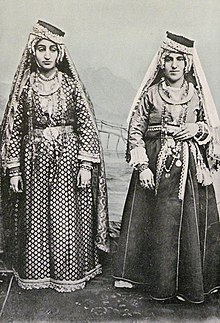
Armenian women in Diyarbakır
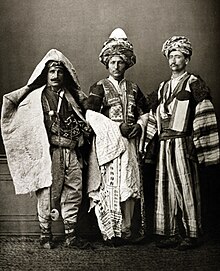
Kurds wearing traditional clothing

Yazidi festival at Lalish

Baloch of Nimruz Province, Afghanistan
Indo-European speakers
Armenians (Hayer): The Christian Armenian people were the original inhabitants of what is now modern Eastern Turkey, specifically around Lake Van and the biblical mountain of Ararat and spoke the Western Armenian language. Since the Armenian Genocide in which up to 1,500,000 people perished, the number of the original Armenian inhabitants is almost non-existent and they have since been replaced with ethnic Turks and Kurds.
Iranian peoples
East Iranian peoples
Northeast Iranian peoples
Ossetians (Iræттæ): South Ossetia, Georgia, Southern Caucasus Mountains
West Iranian peoples
Caspian/South Caspian peoples
Gilaks: Gilan, North Iran, South Caspian Sea coast and Elburz Mountains
Mazanderanis/Mazanis/Tabaris: Mazanderan, Tabaristan, Northern Iran, South Caspian Sea coast and Elburz Mountains
Northwest Iranian peoples- Northwestern I
Kurds (Kurd/Kurmandzh): Kurdistan, Northwestern and Western Iran, Northern Iraq, Northeast and Northern Syria, Southeast Turkey, Zagros and East Anatolian Plateau
Yazidis (Êzidî): Nineveh Province, Northern Iraq
Lak people (Iran): Southwestern Iran, Zagros Mountains
Zaza-Gorani peoples
Shabaks: Sinjar District of the Nineveh Province in northern Iraq.
Zazas: Southeastern Turkey, Upper Euphrates river, East Anatolian Plateau
- Northwestern II
Baluchis (Baloch/Baluch): Baluchistan, Southeastern Iran, Southwestern Pakistan, Extreme Southern Afghanistan- Tatic peoples
Talysh (Talyshon): Northwestern Iran, Far South Azerbaijan, South Caspian Sea coast and Elburz Mountains
Tats (Iran)/South Tats (Irünə Tâtün): Northwest Iran
- Northwestern I
Southwest Iranian peoples- Larestani–Gulf peoples
Kumzaris: Northern Musandam, Oman
- Lurs and Bakhtiaris
Lurs (Lur): Luristan, Western and Southwestern Iran, Zagros Mountains
Bakhtiaris (Bakhtiar): Southwestern Iran, Zagros
Persian people: Iran
Tats (Caucasus): Republic of Azerbaijan, Dagestan (Russia)
- Larestani–Gulf peoples
Caucasus

Traditional Adyghe clothing.
- Indo-European peoples
Armenians (Hayer):
Iranian peoples
East Iranian peoples
Northeast Iranian peoples
Ossetians (Iræттæ): Ossetia (Iryston), North Ossetia (Cægat Iryston), a Republic of Russia, and South Ossetia (Khussar Iryston), a De Jure autonomous region of Georgia (Sakartvelo), self-proclaimed sovereign country, North and South slopes of Central Caucasus Mountains.
West Iranian peoples
Southwest Iranian peoples
Persian peoples
Tats (Caucasus) (Tati/Parsi/Lohijon/Daghli): East Caucasus Mountains, Azerbaijan
Kartvelian peoples
Zan
Lazs (Lazepe): Southwestern Georgia, Far Northeastern Turkey
Northeast Caucasian peoples
Avar-Andic peoples
Avar people (Caucasus) (Magharulal/Avaral): Dagestan, European Russia, Northern Caucasus Mountains
Andic peoples
Akhvakh (Ashvado/Atluatii)
Andis (Qhvannal/Khivannal)
Bagvalals/Bagulals (Bagval)
Botlikhs (Buykhal'ida/Buykhalyi)
Chamalals (Chamalaldu)
Godoberis (Giybdiridi)
Karatas (Khkhiridi)
Tindis (Idarab)
Dargins (Darganti): Dagestan, European Russia, Northern Caucasus Mountains
Khinalug (Kettiturdur/Kayttiodur/Ketid/Ketsh Khalkh)
Lak people (Dagestan) (Lak): Dagestan, European Russia, Northern Caucasus Mountains
Lezgic peoples
Aghul (Agular): Dagestan, European Russia, Northern Caucasus Mountains
Archins (Arshishttib)
Budukh (Budad)
Jeks (Cekad/Dzhekad)
Kryts (Kh'rytsha'/Kyrtuar)
Lezgians (Lezgiyar/Leqer): Dagestan, European Russia, Northern Caucasus Mountains
Rutul (Mykhabyr): Dagestan, European Russia, Northern Caucasus Mountains
Tabasarans: Dagestan, European Russia, Northern Caucasus Mountains
Tsakhur (Yiqby): Azerbaijan, Southern Caucasus Mountains
Udins (Udi/Uti): Northern Azerbaijan, Southern Caucasus Mountains
Nakh peoples
Bats (Batsbi)
Vainakh peoples
Chechens (Nokhchiy): Chechenia, European Russia, Northern Caucasus Mountains
Ingush (Ghalghay): Ingushetia, European Russia, Northern Caucasus Mountains
Tsezic (Didoic) peoples- Bezhtas
Hinukh (Hinuqes)
Hunzibs (Hunzib)
Khwarshi (Khuani)
Tsez/Dido people
Northwest Caucasian peoples
Abkhaz-Abaza peoples
Abazins (Abaza)
Abkhazians (Aphsua): Abkhazia (Aphsny) - a De Jure autonomous region of Georgia (Sakartvelo), self-proclaimed sovereign country.
Circassian peoples
West Circassian peoples
Adyghe (Adyge): Adyghe Republic, European Russia, Northern Caucasus Mountains
East Circassian peoples
Cherkess (Cherkes): Karachay-Cherkessia, European Russia, Northern Caucasus Mountains
Kabardians (Qeberdeykher): Kabardino-Balkaria, European Russia, Northern Caucasus Mountains
Ubykh (Tʷaχ): were indigenous to the mountains of West Caucasus, Sochi area, Krasnodar Krai, Russia, later migrated to Turkey.
Eurasian Steppe

Pamiri people of Tajikistan
- Indo-European peoples
Iranian peoples
East Iranian peoples
Northeast Iranian peoples
Pamiris (Pomir): Badakhshan (Afghanistan, Tajikistan), Pamir Mountains, Tashkurgan (in Xinjiang)
Yaghnobi (Yaγnōbī́t): Tajikistan
Mongolic peoples- Central Mongolic peoples
Khoid: Mongolia
Mangud: Historically Mongolia
Naimans (Nayman): Inner Mongolia, China
Oirats (Oirad/Oird) (Dzungars and Torghuts): Dzungaria (Northern Xinjiang), China
Sartuul: Zavkhan, Mongolia
- Central Mongolic peoples
Sino-Tibetan peoples
Tibetans: Tibet, China and neighbouring regions
Turkic peoples- Common Turks
Karluk Turks (Southeastern Common Turkic peoples)
Uyghurs (Uyghur): Tarim Basin (Southern Xinjiang), China
Salar (Salır): Xunhua Salar Autonomous County, Qinghai province, China
Kipchak Turks (Northwestern Common Turkic peoples)
Bashkirs (Başqorttar): Bashkir Republic, European Russia
Krymchaks (Qrymçaklar):
Crimean Karaites (Qrymqaraylar): Crimean Peninsula in Southern Ukraine
Crimean Tatars (Qırımtatarlar): Crimean Peninsula in Southern Ukraine
Volga Tatars (Tatarlar): Tatarstan, European Russia
Oghuz Turks (Southwestern Common Turkic peoples)
Gagauz (Gagauzlar): Gagauzia, Moldova
SiberianTurks (Northeastern Common Turkic peoples)
Yugur (Yogïr/Sarïg Yogïr): Sunan Yugur Autonomous County, Gansu province, China
Oghur (tribe)
Chuvash (Chăvаsh): Chuvash Republic, Russia
- Common Turks
South Asia

An old Munda man, Dinajpur

Assamese youth in traditional dress

Kodava men in traditional attire, India
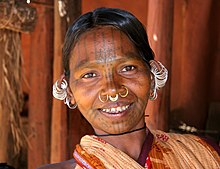
An Adivasi woman from the Kutia Kondh tribal group in Odisha, India

An Indigenous Assamese woman of Assam

Veddha chief Uruwarige Wannila Aththo, leader of the indigenous people Sri Lanka
Adivasis/Dalits: collective term for many indigenous peoples in India (see also List of Scheduled Caste/Scheduled Tribes in India and other indigenous communities)
Austroasiatic peoples
Khasi-Jaintia (Ki Khun U Hynñiewtrep): Meghalaya, Assam, North-East India- Indigenous Assamese people
Munda peoples: Chota Nagpur Plateau, eastern and central India
Juang:
Kharia (Sabar):
Korku (Koruku):
Munda (Munda/Muda/Mura/Mundari): Jharkhand, Assam, Odisha, West Bengal, Chhattisgarh, Bihar and into parts of Bangladesh
Santals (Santhal/Saontal/Satar): Chhattisgarh & West Bengal
Sora (Sora/Saora/Savara):
Dravidian peoples
Badaga: Tamil Nadu, South India
Gond: Gondwana Land, Central India
Irula: Tamil Nadu, South India
Kisan: indigenous peoples of the Orissa Sundergarh, Odisha, East India
Kodava: Kodagu, Karnataka, South India
Kota (Kothar/Kov): Tamil Nadu, South India
Kuruba: Andhra Pradesh, Karnataka, Tamil Nadu, South India
Toda: Tamil Nadu, South India
- Indo-European peoples
Indo-Aryan peoples
Tharu: Nepal, East India
Sino-Tibetan peoples
Bodish peoples
Ladakhi: Jammu and Kashmir, North India
Konyak peoples
Indigenous Assamese people
Tripuri (Borok): Tripura, North-East India
Konyak peoples
Nocte: Tirap, Arunachal Pradesh, North-East India
Kukish peoples
Karbi: Karbi Anglong, Assam, North-East-India
Mizo (Mizo hnam): Mizoram, North-East India
Naga: Nagaland, North-East India
Raji-Raute peoples
Raute: Nepal, North India
Digaro peoples
Mishmi: Arunachal Pradesh, North-East India
Jumma people (a collective term for several peoples)
Chakma: Bangladesh, Arunachal Pradesh - North-East India
Indigenous peoples of Sikkim: India
Sino-Tibetan peoples
Bodish peoples
Bhutia (Denzongpa)
Lepcha (Róng ʔágít/Róngkup/Mútuncí Róngkup Rumkup)
Dravidian peoples
South Dravidian peoples
Giraavaru (Giraavaru): Maldives
Burusho: Hunza and Chitral districts, Gilgit-Baltistan, Northern Pakistan- Indo-European peoples
Iranian peoples
Pashtuns: southern Afghanistan and Northwest Pakistan
Baloch: southeastern Iran, southwest Pakistan
Indo-Aryan peoples
Dard: Dardistan, Khyber-Pakhtunkhwa, Gilgit-Baltistan, Northern Pakistan
Kalasha of Chitral (Kaĺaśa): Ancient pre-Muslim polytheistic pagan ethnic minority in Chitral District, Northern Pakistan
Shina: Gilgit-Baltistan, Northern Pakistan
Kashmiri Hindus: India
Sindhi: Sindh, Pakistan, India
Bengali: India, Bangladesh
Gujarati: India
Sino-Tibetan peoples
Lolo-Burmese peoples
Burmish peoples
Marma: Bangladesh
Vedda (Wanniyala-Aetto): Sri Lanka
Sinhalese: Sri Lanka
Sri Lankan Tamil:Sri Lanka
Dhivehi: Maldives
Southeast Asia
Mainland Southeast Asia (Indochina)

A Wa woman carrying her child
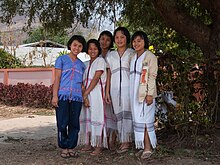
S'gaw Karen girls of Khun Yuam District, Mae Hong Son Province, Thailand
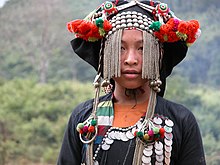
Akha girl in Laos
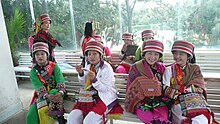
Yi/Nuosu women

A Tai Dam lady in Laomeng village, Jinping Miao, Yao, and Dai Autonomous County, Yunnan Province, China.
Austroasiatic peoples
Aslian peoples
Senoi (Senoi/Sengoi/Sng'oi) (a people of the ethnic groups called by the generic word Orang Asli - Original People): in Peninsular Malaysia)
Khmer Krom: of Vietnam
Khmuic groups:
Khmu (Kmm̥uʔ/Kmmúʔ): Thailand and Laos
Mlabri (Mrabri): Thailand and Laos
Pray: Thailand and Laos
Palaungic peoples
Wa (Vāx): One of the hill tribes of Burma and China's Yunnan Province
Zomi (Zo Pau): One of the indigenous people in Southeast Asia. The word Zomi is the collective name given to many tribes who traced their descends to a common ancestor. Through history they have been known under various appellation, such as—Chin, Kuki and Mizo—but the expression was disliked by them, and they insist that the term was a misnomer given by others and by which they have been recorded in certain documents designate their ancient origins as a race.
Austronesian peoples
Malayo-Polynesian peoples
Chamic peoples
Cham (Urang Campa): of Vietnam and Cambodia
Proto-Malay (a people of the ethnic groups called by the generic word Orang Asli - Original People): in Peninsular Malaysia
Moken (Moken) : in Burma, and Thailand
Hmong-Mien peoples
Hmong: subgroups of Thailand, Burma, Laos, Vietnam and a Chinese minority
Montagnards (Degar): an umbrella term for several Pre-Vietnamese peoples that dwell in the plateaus and mountains of the southern regions of Vietnam
Austroasiatic peoples- Bahnaric peoples
- North Bahnaric peoples
- Sedang
- Central Bahnaric peoples
- Bahnar
- Mnong
- Stieng
- North Bahnaric peoples
Katuic peoples- Katu
- Katu
- West
Bru (Bruu)
- Katu
- Bahnaric peoples
Austronesian peoples
Malayo-Polynesian peoples
Chamic peoples- Highlands Chamic peoples
- Rade-Jarai
- Jarai
- Rhade
- Chru–Northern
- Northern Cham
- Raglai
- Northern Cham
- Rade-Jarai
- Highlands Chamic peoples
Negrito:
Mani (Maniq): Far Southern Thailand
Semang (a group of several peoples of the ethnic groups called by the generic word Orang Asli - Original People): in Peninsular Malaysia- Batek
Sino-Tibetan peoples
Karenic peoples
Karen (Per Ploan Poe/Ploan/Pwa Ka Nyaw/Kanyaw): an alliance of hill tribes of Burma and Thailand
Lolo-Burmese peoples
Akha a.k.a. Aini or Aini-Akha: One of the hill tribes of Thailand, Laos, Burma and China's Yunnan Province
Lahu (Ladhulsi/Kawzhawd): One of the hill tribes of Thailand, Burma, Laos and Yunnan.
Lisu: One of the hill tribes of Burma, Thailand, Arunachal Pradesh, India & Yunnan and Sichuan, China
Rakhine (Rəkhàin lùmjó): Arakan in Burma
Yi (Nuosu/Nisu/Sani/Axi/Lolo): a group of several related peoples in Southern China, mainly in Yunnan Province.
Tai peoples: in China, Vietnam, Burma, Laos and Thailand
Southwestern Tai peoples
Khün (Thai Khün)- Phu Thai
- Tai Dam
- Tai Lu
- Tai Nüa
Maritime Southeast Asia (Indonesia)

A Murut man (a member of one of the Dayak ethnicities) in Monsopiad Cultural Village, Kg. Kuai Kandazon, Penampang, Sabah, Borneo Island

Ati woman, the Philippines, 2007[16] The Negritos were the earliest inhabitants of Southeast Asia.[17]
Austroasiatic peoples
Nicobarese people (Holchu): Nicobar Islands, India
Shompen (Kalay-Keyet): Nicobar Islands, India
Austronesian peoples
Malayo-Polynesian peoples
Barito peoples
Bajau (Sama/Samah/Samal): Borneo and the Sulu Archipelago (Malaysia, Indonesia, Philippines)
Dayak: Borneo, (Malaysia and Indonesia)
Malayic peoples
Orang Laut and Orang Seletar: Malaysia and Singapore
Proto-Malay (Melayu asli/Melayu purba): Malaysia
North Bornean peoples
Penan: Sarawak, Malaysia
Lun Bawang: Sarawak, Malaysia
Philippine peoples
Igorot (Ifugao/Ipugao): Cordillera mountains in Luzon in the Philippines
Lumad (Katawhang Lumad): Mindanao in the Philippines
Mangyan: Mindoro in the Philippines
Moro: Mindanao and Sulu archipelago in the Philippines
Tausug (Tausūg/Suluk/Sulug)- Maguindanao
Maranao (Iranon/Iranun)
Tribes of Palawan: Palawan, Philippines
Negrito:
Aeta: Luzon, Philippines
Andamanese, in the Andaman Islands, which include:
Great Andamanese: formerly at least 10 distinct groups living throughout Great Andaman, now confined to a single community on Strait Island, Andaman Is.
Jangil (Rutland Jarawa): now extinct, formerly of Rutland Island, Andamans
Jarawa: South Andaman and Middle Andaman
Onge (Önge): Little Andaman, Andaman Islands
Sentinelese (?): North Sentinel Island, Andaman Islands
Ati: Panay, Philippines
Batak: Palawan, Philippines
Pribumi (Native Indonesians): of Indonesia
East Asia
North China
Tungusic peoples
Northern Tungusic peoples
Oroqen (Oroqen): Far Northern China
Southern Tungusic peoples
Manchu (Manju/Jurchen): Manchuria, northeast China
South China

Miao (Hmong) girls in China

Bunun dancer
Hmong-Mien peoples
Miao (Hmong)
Yao (Mien)
Taiwan
Taiwanese aborigines: the island of Taiwan
Austronesian peoples- Amis peoples
Amis (Pangcah/Amis)
Sakizaya (Sakuzaya)
- Bunun
Kavalan (Kbaran)- Northern Formosan peoples
Atayal/Tayal/Tayan- Saisiyat
- Seediq and Truku
- Seediq
- Truku
Yami (Tao)
Thao/Ngan
- Paiwan
Puyuma/Pinuyumayan- Tsou-Rukai peoples
- Rukai
- Tsou
- Amis peoples
Japan
Ainu (Aynu): Hokkaido, Japan and (until the end of World War II) on Sakhalin Island, Russia
Japonic peoples
Ryukyuans (Ruuchuu Minzuku): Old Ryūkyū Kingdom, now Japan
Siberia
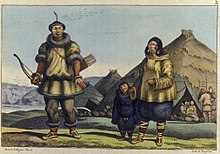
Representation of a Chukchi family by Louis Choris (1816)

Buryat shaman of Olkhon, Lake Baikal in eastern Siberia.

Nenets child
Northern indigenous peoples of Russia: Over 40 distinct peoples, each with their own language and culture in the Asiatic part of Russia (Siberia).
Chukchi-Kamchatkan peoples
Chukotkan peoples
Chukchi (Lyg'oravetl'et/O'ravetl'et/Ankalyn-Chavchu): Northeast Siberia, Russia
Koryaks (Nymylan-Chauchuven): Russian Far East
Eskimo-Aleut peoples
Yupik: Alaska and the Russian Far East
Siberian Yupik (Yupighyt): Siberia, Russia, Alaska, United States.
Sirenik Eskimos, Russian Far East.
Naukan, Russian Far East.
Mongolic peoples- Central Mongolic peoples
Buryats (Buryaad): Buryatia, Russia
- Central Mongolic peoples
Tungusic peoples- Northern Tungusic peoples
Evenks (Evenkil): China, Mongolia, Russia
- Northern Tungusic peoples
Turkic peoples
Siberian Turks
Altayans (Altay-kishi): Titular nation of Altai Republic
Khakas (Tadarlar):
Tuvans (Tyvalar): Tuva Republic, close to the Altai Mountains
Yakuts (Sakha): Yakutia, Siberia, Russia
Kipchak Turks- Siberian Tatars
- Baraba Tatars
Uralic peoples
Finno-Ugric peoples
Permians (on the basis of "Siberia" as a cultural region of Northern Eurasia that overlaps with Far North Eastern Europe in Far North European Russia and with parts of Northwest Europe in North Scandinavia)
Komi (Komiyas): Komi Republic in Northeast of European Russia
Udmurts (Udmurt'yos): Udmurt Republic in Northeast of European Russia
Sami (Sámi/Saami/Lapp): Sápmi, Northern and central Norway, Northern Sweden, Northern Finland and Kola peninsula in the Northwest of Russia
Volga Finns
Mari (Mari): Middle Volga, European Russia
Mordvins (Erzyat, Mokshet): European Russia
Erzyans (Erzyat)
Moksha (Mokshet)
Ugric peoples: Yugra, Western Siberia, Russia
Khanty (Hantõ-Kantõk/Kantek/Khanti): Yugra, Western Siberia, Russia
Mansi (Maan's'i/Maan's'i Maahum/Mansi), formerly known as Voguls: Yugra, Western Siberia, Russia
Samoyedic Peoples
Northern Samoyedic peoples: West Siberia and Far Northern European Russia
Enets (Entsi): Far Northern Western Siberia, Russia
Nenets (Neney Neneche): Far Northern Western Siberia and Far Northern European Russia
Nganasan (Ŋənəhsa(nəh)): Taymyr Peninsula, Siberia, Russia
Yukaghirs (Odul/Vadul/Detkil'): Far Northern East Siberia, Russia
Yeniseian peoples
Ket (Deng): Along middle Yenisei river banks
Europe
Eastern Europe

Gagauz old and young people.

Mordvin women of Penza Oblast dressed in traditional costumes.
Turkic peoples- Common Turks
Kipchak Turks (Northwestern Common Turkic peoples)
Bashkirs (Başqorttar): Bashkir Republic, European Russia
Crimean Karaites (Qrymqaraylar): Crimean Peninsula in Southern Ukraine
Crimean Tatars (Qırımtatarlar): Crimean Peninsula in Southern Ukraine
Volga Tatars (Tatarlar): Tatarstan, European Russia
Oghuz Turks (Southwestern Common Turkic peoples)
Gagauz (Gagauzlar): Gagauzia, Moldova
Oghur Turks
Chuvash (Chăvаsh): Chuvash Republic, Russia
- Common Turks
Uralic peoples
Finno-Ugric peoples
Baltic Finns
Izhorians (Ižoralaizet/Inkeroine/Izhora/Izhoralaine/Karjalain/Maaväki): Northwest of Russia
Karelians (Karjalaižet): Northwest of Russia
Livonians (Raandalist/Kalamied/Liivõd/Liibõd/Liivnikad/Liivlist): Far Northern Courland peninsula, Latvia
Setos (Setokõsõq): Setomaa - Far Southeastern Estonia, southern border region between Estonia and Russia, East Võru County and Northwest Pskov Oblast, southwest of Chudskoye-Pskov/Peipus Lake.
Veps (Vepslaine/Bepslaane/Lüdinik/Lüdilaine): Republic of Karelia, Northwest of Russia
Permians
Komi (Komiyas): Komi Republic in Northeast of European Russia
Udmurts (Udmurt'yos): Udmurt Republic in Northeast of European Russia
Sami (Sámi/Saami/Lapp): Sápmi, Northern and central Norway, Northern Sweden, Northern Finland and Kola peninsula in the Northwest of Russia
Volga Finns
Mari (Mari): Middle Volga, European Russia
Mordvins (Erzyat, Mokshet): European Russia
Erzyans (Erzyat)
Moksha (Mokshet)
Samoyedic peoples
North Samoyedic peoples
Nenets (Neney Neneche) : Northeastern part of European Russia
Northern and western Europe
- The Sami (traditionally known as Lapps in English) are indigenous to Sápmi (Lapland) in northern Norway, Sweden, Finland and the Kola peninsula in Russia. They are legally recognised as indigenous peoples in all four countries.[18][19]
- In the United Kingdom, crofters have asked to be designated as indigenous peoples of the Scottish Highlands. The UK government does not officially recognise any indigenous peoples within the country.[20]
Oceania
Oceania includes most islands of the Pacific Ocean, New Guinea and the continent of Australia.
List of peoples by geographical and ethnolinguistic grouping:
Australia

Aboriginal farmers in Victoria, Australia, 1858
Australia includes the continental landmass, and associated islands.
Indigenous Australians by native cultural regions
North
Australian Aborigines
Tiwi: Tiwi Islands, Northern Territory, Australia
Arnhem
Australian Aborigines
Pama-Nyungan peoples
Yolngu/Yolŋu: Arnhem Land, Australia
Desert
Australian Aborigines
Pama-Nyungan peoples
Wati Pama-Nyungan peoples (former Southwest Pama-Nyungan peoples)
Pintupi: Western Australia, Australia
Spinifex people (Anaṉgu tjuta pila nguru/Pila Nguru): Great Victorian Desert, Western Australia, Australia.
Torres Strait
Indigenous Australians
Torres Strait Islanders: Torres Strait, Australia
Rainforest
Indigenous Australians
Djabugay: Cairns region, Queensland, Australia
Tasmania
Indigenous Australians
Palawa (Aboriginal Tasmanians): Tasmania, Australia
Melanesia
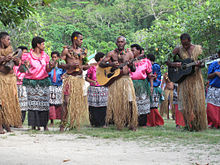
Fijians.

Yali people in New Guinea
Melanesia generally includes New Guinea and other (far-)western Pacific islands from the Arafura Sea out to Fiji. The region is mostly inhabited by the Melanesian peoples.
Melanesians
Austronesian speaking Melanesians
Fijians (iTaukei): Fiji
Kanak: New-Caledonia
Malaitan people: Malaita, Solomon Islands
Ni-Vanuatu: Vanuatu
Papuan speaking Melanesians- Baining
Papuans: more than 250 distinct tribes or clans, each with their own language and culture. The main island of New Guinea and surrounding islands (territory forming independent state of Papua New Guinea (PNG) and the Indonesian provinces of West Papua and Papua. Considered "Indigenous" these people are a subject to many debates.
Sepik peoples
Kwoma: Peilungua Mountains, Papua New Guinea.
Iatmul: Sepik, Papua New Guinea.- Sepik Hill
- Sanio
Hewa: Southern Highlands, PNG
- Sanio
Trans New-Guinean peoples
Huli of the Southern Highlands, Papua New Guinea.
Angu: Southwestern Morobe Province, Papua New Guinea.- Bosavi
- Kaluli-Kasua
Kaluli: Great Papuan Plateau, PNG
- Kaluli-Kasua
- Ok
- Mountain Ok
Wopkaimin: western PNG, Star Mountains.
- Mountain Ok
West Trans New-Guinean peoples
Dani: Papua, Indonesia
Korowai: West Papua, close to the Papua New Guinea border.
Asmat: Asmat Regency, West Papua.
Micronesia
Micronesia generally includes the various small island chains of the western and central Pacific. The region is mostly inhabited by the Micronesian peoples.
Micronesian peoples
Chamorros: Northern Marianas and Guam
Polynesia

Samoan family
Polynesia includes New Zealand and the islands of the central and southern Pacific Ocean. The region is mostly inhabited by the Polynesian peoples.
Polynesians- Ellicean–Outlier
Tuvaluan people: Tuvalu
- Futunic
Uvea and Futuna:Wallis and Futuna
- Marquesic
Kanaka Maoli: Hawaii, United States- Marquesan and Mangarevan
Mangareva: Gambier Islands
Marquesas Islanders: Marquesas Islands
Rapanui: Easter Island (Rapanui)- Samoic
Samoans (Tagata Māo‘i): Samoa, American Samoa
Tokelau: Tokelau
- Tahitic
Austral Islanders: Austral Islands
Cook Islands Māori: Cook Islands
Maohi: Tahiti
Māori: New Zealand (Aotearoa)
Moriori: Chatham Islands (Rēkohu)
Tahitians (Ta'ata Tahiti (Ma'ohi)) : Tahiti, French Polynesia
Tuamotu: Tuamotu Archipelago
- Tongic
Niueans: Niue
Tongans: Tonga
- Ellicean–Outlier
Polynesian outliers
Polynesians- Ellicean–Outlier
Kapingamarangi and Nukuoro: The Federated States of Micronesia
Nuguria Papua New Guinea
Nukumanu Papua New Guinea
Takuu: Papua New Guinea- Ontong Java
- Sikaiana
- Futunic
Anuta: Solomon Islands
Fagauvea: Ouvéa (New Caledonia)
Futuna and Aniwa: Vanuatu- Futuna
- Aniwa
Emae: Vanuatu- Makata: Vanuatu
Mele (Erakoro, Eratapu): Vanuatu
Rennel and Bellona: Solomon Islands- Bellona
- Rennel
Tikopia: Solomon Islands
Vaeakau-Taumako: Solomon Islands
- Ellicean–Outlier
The Americas
The Americas is the supercontinent comprising North and South America, and associated islands.
List of peoples by geographical and ethnolinguistic grouping:
North America
North America includes all of the continent and islands east of the Bering Strait and north of the Isthmus of Panama; it includes Greenland, Canada, United States, Mexico, Central American and Caribbean countries. However a distinction can be made between a broader North America and a narrower Northern America and Middle America due to ethnic and cultural characteristics.
Indigenous peoples in North America by Country
Aboriginal peoples in Canada- First Nations
- Inuit
- Métis
Indigenous peoples in the United States- Alaska Natives
- Indigenous peoples of Mexico
Indigenous peoples in North America by native cultural regions
Arctic

Two Inuit women in traditional amauti (packing parkas)
Ancient Beringian - Siberia and Alaska
Eskimo–Aleut
Aleut (Unangax): Aleutian Islands and Kamchatka Krai
Eskimo/Yupit-Inuit
Yupik: Alaska, United States
Alutiiq (Sugpiat): Alaska, United States
Central Alaskan Yup'ik (Yupiat/Yupiit): Alaska, United States
Cupik (Cupiit): Alaska, United States
Siberian Yupik of St. Lawrence Island, Alaska, United States.
- Inuit peoples: Canadian Arctic - Northwest Territories, Nunavik, Nunatsiavut, Nunavut; Greenland; Alaska, United States
Greenlandic Inuit: Greenland
Inughuit: North Greenland
Kalaallit: West Greenland
Tunumiit: East Greenland
Inupiat (Iñupiat): Alaska's Arctic, North Slope and boroughs and the Bering Strait
Nunamiut: Interior Alaska.
Inuit proper (Inuit): Canadian Arctic- Eastern Canadian Inuit: East Canadian Arctic, East Nunavut, Nunavik, Nunatsiavut
Western Canadian Inuit (Inuvialuit): West Canadian Arctic, Inuvialuit Settlement Region, Arctic coast of Northwest Territories, West Nunavut
- Eastern Canadian Inuit: East Canadian Arctic, East Nunavut, Nunavik, Nunatsiavut
Métis: a mixed First Nations (from several peoples) and European (from several peoples) people of Canada.
Subarctic
- Na-Dené peoples
- Athabaskan peoples
- Northern Athabaskan peoples
Dene of Yukon, British Columbia, Manitoba, Northwest Territory, and Alberta, Canada.
Alaskan Athabaskans- Southern Alaskan peoples
- Ahtna
- Ingalik
Koyukon of Interior Alaska.
Kutchin of Interior Alaska and the Yukon.
Tanana Athabaskans.
Kolchan of Interior Alaska.
Deg Hit'an of Interior Alaska.
Dena'ina of Interior Alaska.- Holikachuk
Hän of Yukon, Canada, and Alaska, United States.
- Southern Alaskan peoples
- Northern Athabaskan peoples
- Athabaskan peoples
Métis: a mixed Native American (from several peoples) and European (from several peoples) people of Canada.
Algonquians
Cree of Montana, United States, and Manitoba, Alberta, and Saskatchewan, Canada.
Innu of Northeastern Quebec, and Western Labrador, Canada.
Annishinabe of Quebec, Ontario, and Manitoba, Canada, as well as Kansas, Michigan, Minnesota, Oklahoma, and Wisconsin, United States.
Algonquin of Quebec, and Ontario, Canada.
Beothuk of Newfoundland, Canada.
Pacific Northwest Coast
Makah of Washington, United States.
Quinault of Washington, United States.
Nootka of British Columbia, Canada.
Kwakiutl of British Columbia, Canada.
Eyak of Alaska, United States.
Haida of British Columbia, Canada, and Alaska, United States.
Tlingit of Alaska, United States.
Tshimshian of British Columbia, Canada, and Alaska, United States.
Northwest Plateau-Great Basin-California
Northwest Plateau
Great Basin
Ute of Utah, United States.
Shoshone of Colorado, Nevada, and Utah, United States.
Mono of California, United States.
Bannock of Idaho, United States.
Western Shoshone of Nevada, United States.
Timbisha of Nevada, United States.
Washoe of Nevada, United States.- Paiute of Colorado, California, Nevada, and Utah, United States.
Northern Paiute.
Southern Paiute.
Pais of Colorado, Arizona, and New Mexico, United States, as well as Baja California, Mexico.
Hualapai of Arizona, United States.
Walapai of Arizona and Colorado, United States.
California
Yuman-Cochimi peoples
Cochimí people: Baja California, Mexico- Core Yuman peoples
Kiliwa (K'olew): Baja California, Mexico
Paipai (Akwa'ala/Yakakwal): Baja California, Mexico- Delta-Californian peoples
Cocopa (Xawiƚƚ Kwñchawaay): Baja California, Mexico, and Arizona, United States.
Kumeyaay (Kumeyaay/Ipai-Tipai/MuttTipi): Baja California, Mexico, and California, United States.
Miwok of California, United States.
Maidu of California, United States.
Wintu of California, United States
Chumash of California, United States.
Tongva of California, United States.
Modoc of California, and Oregon, United States.
Athabaskans
Achumawi of California, and Oregon, United States.
Hupa of California and Oregon, United States.
Cahuilla of California, United States.
Mojave of California, and Nevada, United States.
Uto-Aztecans
Mono of California, and Nevada, United States.
Northern Paiute of California and Nevada, United States.
Ohlone of California, United States.
Karok of California, United States.
Great Plains
Comanche of Texas and Oklahoma, United States.
Osage of Kansas and Nebraska, United States.
Sioux of North Dakota, South Dakota, and Minnesota, United States, as well as Saskatchewan, and Alberta, Canada.
Lakota of South Dakota, United States.
Dakota people of Minnesota, United States, and Saskatchewan, Canada.
Kiowa of Texas, and Oklahoma.
Plains Apache (see the Southwest section for another category this tribe belongs too) of Texas, and Oklahoma.
Crow of Montana.
Omaha of Nebraska.
Blackfoot of Montana, United States, and Saskatchewan, Canada.
Eastern Woodlands
Northeastern Woodlands
Iroquoian peoples
Haudenosaunee of New York, Wisconsin, and Oklahoma, United States, as well as Quebec and Ontario, Canada.
Mohawk of Quebec, Canada, and New York, United States.
Seneca of New York, and Oklahoma, United States, as well as Ontario, Canada.
Cayuga of Oklahoma, and New York, United States, as well as Ontario, Canada.
Oneida of Wisconsin and New York, United States, as well as Ontario, Canada.
Tuscarora of New York, United States, and Ontario, Canada.
Onondaga of New York, United States, and Ontario, Canada.
Wyandot of Kansas, Michigan, and Oklahoma, United States, as well as Ontario, Canada.
Nation du chat of Upstate New York, Ohio, and Northwest Pennsylvania, United States.
Susquehannock of Pennsylvania, and West Virginia, United States.
St. Lawrence Iroquoians: St. Lawrence River, Quebec, Canada, and New York, United States.
Monongahela: Pennsylvania, West Virginia, and Ohio, United States.
Nottoway of Virginia, United States.
Westo of Virginia and South Carolina, United States.
Algic peoples
Algonquian peoples
Chowanoke of North Carolina.- Carolina Algonquian
Roanoke of North Carolina.
Croatan of North Carolina.
Powhatan Confederacy of Virginia.
Pamunkey of Virginia, United States.
Powhatan people of Virginia, United States.
Wampanoag of Massachusetts.
Wabanaki of Maine, United States, and New Brunswick and Newfoundland, Canada.
Abenaki of New Hampshire, Maine and Vermont.
Penobscot of Maine.
Miqmac of New Brunswick, and Newfoundland.
Passamaquoddy of Maine, United States, and New Brunswick, Canada.
Maliseet of New Brunswick and Quebec.
Shawnee of the Ohio River Valley, now Oklahoma.
Central Algonquian peoples
Kikapú (Kiikaapoa/Kiikaapoi): indigenous from southeast Michigan, United States, also in Coahuila, Mexico
Peoria (Illiniwek)
Annishinabe
Ojibwe of Minnesota, North Dakota, and Michigan, United States, as well as Ontario, Canada.
Potawatomi of Michigan and Indiana, United States, as well as Ontario, Canada.
Odawa of Oklahoma and Michigan, United States, as well as Ontario, Canada.
Cree of Alberta, Manitoba, Ontario, Saskatchewan, and the Northwest Territories, Canada, as well as Montana, United States.
Southeastern Woodlands
Cherokee of North Carolina, Georgia, and Oklahoma.
Natchez of Louisiana, and Arkansas.
Muskogeans
Muskogee of Georgia, now Oklahoma.
Choctaw of Louisiana, Alabama, and Oklahoma.
Chickasaw of Tennessee, now Oklahoma.
Indigenous peoples of Florida
Indigenous people of the Everglades region
Calusa of South Florida.
Tequesta of South Florida.
Timucua of Northern Florida and Southern Georgia.
Apalachee of the Florida Panhandle and Alabama.
Seminole of Oklahoma, and Florida.
Siouans
Ho-Chunk of Wisconsin and Michigan.
Catawba of North Carolina.
Pee Dee of South Carolina.
Caddoans
Caddo of Texas, Arkansas, and Louisiana.
Pawnee of Oklahoma and Arkansas, United States.
Southern Plains villagers of Western Oklahoma, Texas, Kansas, and Southeastern Colorado.
Arikara of North Dakota, United States.
Hidatsa of North Dakota, United States.
Wichita of Oklahoma, Kansas, and Texas, United States.
Southwest
Uto-Aztecan peoples
Aztecan (Nahuan) peoples
Mexicanero (Mēxihcah): Durango, Mexico
Cáhitan peoples
Yaqui (Hiaki/Yoeme): Sonora, Mexico, and Arizona, United States.
Mayo (Yoreme): Sonora, Mexico
Tarahumaran peoples
Guarijío: Sonora, Mexico
Tarahumara (Rarámuri-Omugí): Chihuahua and Durango, Mexico
Tepiman peoples
Pima Bajo: Chihuahua, Mexico
Tepehuán (O'dam/Audam/Ódami): Chihuahua and Durango, Mexico
Seri (Comcaac): Sonora, Mexico
Puebloan peoples: Colorado, New Mexico, Arizona, Utah, and Texas, United States
Hopi of New Mexico, United States.
Zuni of Arizona, United States.
Anasazi of New Mexico and Colorado, United States.
Tiwa of New Mexico, United States.
Mogollon of New Mexico, Arizona, United States, and Sonora, Mexico.
Hohokam of Southern Arizona, United States.
Southern Athabascans
Apache of Chihuahua, Coahuilla, and Sonora, Mexico, as well as Arizona, New Mexico, Oklahoma, and Texas, United States.
Chiricahua of Southern New Mexico, Northern Mexico, and Southeast Arizona.
Lipan Apache of Northern Texas, and Western Oklahoma.
Plains Apache of Oklahoma.
Mescalero of Arizona, New Mexico, and Northern Chihuahua.
Western Apache of Western Arizona.
Navajo of the Four Corners region.
O'odham of Sonora, Mexico, and Arizona, United States.
Pima of Arizona, United States.
Papago of far Northern Sonora, Mexico, and Southern Arizona, United States.
Mesoamerica

Tzeltal dancers waiting to perform, San Cristobal.

Mam people.
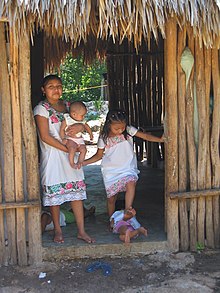
Mayan family from Yucatán

Amuzgos in traditional dress.

Mazatec girls performing a dance in Huautla de Jimenez.
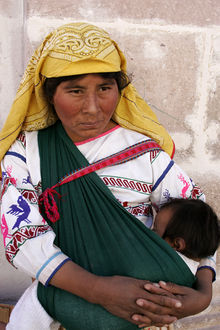
Huichol woman and child.
Huave (Ikoots/Kunajts): Oaxaca, Mexico
Lenca: Honduras and El Salvador
Maya peoples
Ch'olan peoples
Ch'ol: Chiapas, Mexico
Ch'orti': El Salvador
Chontal Maya (Yokot'anob/Yokot'an): Tabasco, Mexico
Tzeltal (Winik Atel/Batzil’op): Chiapas, Mexico
Tzotzil (Tzotzil/Bats'ik'op/Sotz'leb): Chiapas, Mexico
Huastec (Téenek/Te' Inik): San Luis Potosí, Mexico
Mamean peoples
Ixil: Guatemala
Mam: Guatemala
Q'anjobalan peoples
Chuj: Guatemala
Jakaltek: Guatemala – also called Poptí
Q'anjob'al: Guatemala
Tojolabal: Guatemala
- Qichean peoples
Achi': Guatemala
Kaqchikel: Guatemala
K'iche': Guatemala
Poqomchi': Guatemala
Poqomam: Guatemala
Q'eqchi': Guatemala
Tz'utujil: Guatemala
Yucatecan peoples
Itza: Guatemala
Lacandón (Hach Winik): Chiapas, Mexico
Mopan: Guatemala and Belize
Yucatec Maya (Maya proper) (Màaya): Yucatán, Quintana Roo and Campeche, Mexico
Mixe-Zoquean peoples
Mixe (Ayüükjä'äy): Oaxaca, Mexico
Zoque: Oaxaca and Chiapas Mexico
Oto-Manguean peoples
Amuzgo (Tzjon Non/Tzo'tyio/Ñ'anncue): Oaxaca, Mexico
Chinantec: Oaxaca, Mexico
Manguean
Chorotega/Mangue (Mankeme): Honduras, Nicaragua, and Costa Rica
Mixtecan
Cuicatec:Oaxaca, Mexico
Mixtec (Ñuù Savi/Nayívi Savi/Ñuù Davi/Nayivi Davi): Oaxaca, Mexico
Trique: Oaxaca, Mexico
Oto-Pamean peoples
Chichimeca Jonaz (Úza): San Luis Potosí, Mexico
Matlatzinca: Mexico (state), Mexico
Mazahua (Tetjo Ñaa Jñatjo): Mexico (state), Mexico
Otomi (Hñähñu/Hñähño/Ñuhu/Ñhato/Ñuhmu): Central Mexico, Mexico
Pame (Xi'úi): San Luis Potosí, Mexico
Popolocan peoples
Chocho (Ngiwa): Oaxaca, Mexico
Ixcatec: Oaxaca, Mexico
Popoloca: Oaxaca, and Puebla, Mexico
Mazatec (Ha Shuta Enima): Puebla and Oaxaca, Mexico
Tlapanec (Me'phaa): Guerrero, Mexico
Zapotecan peoples
Chatino (Kitse Cha'tño): Oaxaca, Mexico
Zapotec (Be'ena'a/Didxažon): Oaxaca, Mexico
Tarascan (P'urhépecha): Michoacán, Mexico
Tequistlatecan/Chontal de Oaxaca: Oaxaca, Mexico
Totonacan peoples
Totonac (Tutunacu): Veracruz and Puebla, Mexico
Uto-Aztecan peoples
Aztecan (Nahuan) peoples
Nahua (Nāhuatlācah): Mexico
- Corachol peoples
Cora (Náayarite): Jalisco and Nayarit, Mexico
Huichol (Wixáritari/Wixárita): Jalisco and Nayarit, Mexico
Xinca (Xinka): Guatemala
Circum-Caribbean

A Kuna woman in traditional dress.

Umalali featuring the Garifuna Collective on the Peace Corps World Stage at Smithsonian Folklife Festival 2011
Chibchan peoples
Boruca: Costa Rica
Bribri: Costa Rica
Naso/Teribe/Tjër Di: Panama
- Guaymi/Waimi peoples
Bokota: Panama
Ngöbe–Buglé: Panama
Guaymi: Panama
Talamanca peoples
Kuna (Dule/Tule): Panama
Pech: Honduras
Votic peoples
Maleku: Costa Rica
Rama: Nicaragua
Chocó/Embera-Wounaan peoples
Emberá/Chocó proper (ɛ̃berá): Panama
Misumalpan peoples
Miskito (Miskitu): Honduras and Nicaragua
Tawira Miskito (Tawira Miskitu)
Sumalpan peoples
Sumo (Mayangna): Nicaragua
Tolupan/Jicaque: Honduras
Zambo/Cafuso peoples (mixed West African and Amerindian peoples)
Garífuna: A mixed West African (from several peoples) and Amerindian people (mainly from the Island Caribs - Kalhíphona) that traditionally speaks an Arawakan language in Belize and Honduras.
Miskito Sambu: A mixed West African (from several peoples) and Amerindian people (mainly from the original Miskito) that traditionally speaks Miskito, a Misumalpan language, and also Nicaragua Creole English in Nicaragua and Honduras.
African Seminoles: Florida, The Bahamas, and Mexico. (Mixed Seminole and African).
Caribbean

Portrait of the Kali'na exhibited at the Jardin d'Acclimatation in Paris in 1892
The Caribbean, or West Indies, generally includes the island chains of the Caribbean.
Arawakan peoples- Northern
Circum-Caribbean/Ta-Arawakan peoples
Eyeri/Igneri: Lesser Antilles. An Arawak people, may have been the Kalinago/Island Caribs before caribbeanization. (The Island Caribs had the tradition that the Igneri were the older people of Lesser Antilles but they could have been ancestors of the majority of Island Caribs).
Island Caribs (Carib/Kalinago/Kalhíphona): Lesser Antilles. Often called "Island Caribs" (but may have been an older arawak people with a carib conquering warrior elite or influenced by Mainland Caribs. Apparently, the majority of the people spoke an arawakan language and not a carib one.)
Taíno: Amerindians who originally inhabited the Greater Antilles of the Caribbean, they are of Arawakan descent.
Neo-Taíno nations Some scholars distinguish between the Taíno and Neo-Taíno groups. Neo-Taíno groups were also Amerindians of the Antilles islands, but had distinctive languages and cultural practices that differed from the High Taíno.[21] These groups include:
Ciboney: a term preferred in Cuban historical texts for the neo-Taino-Siboney nations of the island of Cuba.
Ciguayo: Eastern Hispaniola
Lucayans: Based in the Bahamas.
Macorix: Hispaniola.
- Northern
Guanahatabey people: Western Cuba island, a Pre-Arawakan and Pre-Island Carib people of the Caribbean Islands.
South America

Emberá women
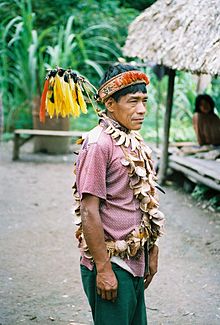
Urarina shaman, 1988
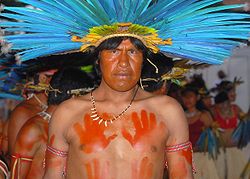
Bororo-Boe man from Mato Grosso at Brazil's Indigenous Games, 2007

Pai Tavytera people in Amambay Department, Paraguay, 2012
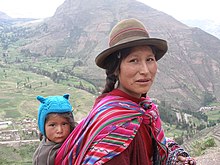
Quechua woman and child in the Sacred Valley, Peru
South America generally includes all of the continent and islands south of the Isthmus of Panama.
Indigenous peoples in South America by Country:- Indigenous peoples in Argentina
- List of indigenous peoples in Brazil
- Indigenous peoples in Chile
- Indigenous peoples in Colombia
- Indigenous peoples in Ecuador
- Indigenous peoples in Peru
Indigenous peoples in South America by native cultural regions
Circum-Caribbean (Chibcha)
Arawakan peoples- Northern
Ta-Arawakan
Wayuu: Venezuela/Colombia
- Northern
Chibchan peoples- Chibcha–Motilon
- Chibcha–Tunebo
U'wa: Colombia
- Chibcha–Tunebo
- Kuna–Colombian
Kuna (Dule/Tule): Panama
- Chibcha–Motilon
Chocoan peoples
Embera (ɛ̃berá): Colombia/Panamá
Warao: Venezuela's Orinoco River delta region.
Amazon
Arawakan peoples- Southern
- Campa
Asháninka: Peru
- Campa
- Southern
Barbacoan peoples- Awan
Awá-Kwaiker: Northern Ecuador
- Awan
Bora-Witoto peoples
Bora: Colombia/Peru
- Cahuapanan peoples
Chayahuita: Loreto, Peru
Jivaroan (Shuar): Loreto and San Martín, Peru
Nukak: Colombia
Panoan peoples- Mainline Panoan
- Nawa
- Chama
Shipibo-Conibo people: Ucayali, Peru
Shipibo: Ucayali, Peru
- Headwaters
Yora: Amazon rainforest, southeast Peru
- Chama
- Nawa
- Mayoruna
- Mayo
Korubu (Dslala): Brazil
Matis: Brazil/Peru
Matsés: Brazil/Peru
- Mayo
- Mainline Panoan
Ticuna-Yuri peoples
Ticuna (Tikuna): Brazil/Peru/Colombia
Tucanoan peoples- Eastern
- North
Tukano: Colombia
- North
- Western
- Napo
- Siona–Secoya
Secoya: Loreto, Peru/Ecuador
- Siona–Secoya
- Napo
- Eastern
Tupian peoples
Tupí-Guaraní
Tupi: Paraguay, Brazil, Bolivia, Peru and Argentina- Cocama-Omagua
Cocama-Cocamilla (Kokáma): Loreto, Peru
- Cocama-Omagua
Tapirape: Brazil- Wayampí
- Guajá
Awá-Guajá: eastern Amazonian rainforest, Brazil
- Guajá
Urarina (Kachá): Chambira Basin, Loreto Peru
Yanomami (Yanõmami/Yanõmami Thëpë): Venezuela/Brazil
Guianas
Cariban peoples
Galibi/Kalina (Mainland Caribs): Guianas, Venezuela (northern coast of South America- Yekuana
- Eñapa (Panare)
- Pemóng
- Pemóng
Makuxi: Brazil, Guyana
Yanomami (Yanõmami/Yanõmami Thëpë): Venezuela/Brazil
Piaroa (Wothïha): Venezuela/Colombia
Eastern Highlands (Brazilian Highlands)
- Charruan peoples
Charrúa: Uruguay, Brazil and Argentina
Macro-Gê peoples- Bororoan
Bororo: Mato Grosso, Brazil
- Ofaie
Karajá/Iny: Brazil
- Bororoan
Tupian peoples
Tupí-Guaraní
Guaraní (I)
Ache: Paraguay
Pai Tavytera: Paraguay- Guaraní
Guaraní (Abá/Avá): Paraguay, Uruguay, Brazil, Bolivia and Argentina
Tupi: Paraguay, Brazil, Bolivia, Peru and Argentina- Cocama-Omagua
Cocama-Cocamilla (Kokáma): Loreto, Peru
- Cocama-Omagua
Tapirape: Brazil- Wayampí
- Guajá
Awá-Guajá: eastern Amazonian rainforest, Brazil
- Guajá
Chaco
Mascoian peoples
Enxet: Paraguay
Matacoan peoples
Wichí: the Chaco, Argentina/Bolivia
Zamucoan peoples
Ayoreo: the Chaco, Paraguay/Bolivia
Andes
Aymaran peoples
Aymara: Peru/Bolivia/Chile
Nasa: Colombia
Quechuan peoples
Quechua (Nunakuna/Runakuna/Kichwa/Inga)
Southern Cone
Araucania
Araucanian peoples
Araucanians (Mapuche): Chile/Argentina
Patagonia
Fire Land (Tierra del Fuego)
Alacalufe (Kawésqar): Far Southern Chile
Yaghan (Yámana): Far Southern Chile
Fuegans of Tierra del Fuego, divided by Chile and Argentina.
Circumpolar
Circumpolar peoples is an umbrella term for the various indigenous peoples of the Arctic.
List of peoples by ethnolinguistic grouping:
- "Paleosiberian"
Chukotko-Kamchatkan
Chukchi (Lyg'oravetl'et/O'ravetl'et): Siberia, Russian Far East, Russia
Koryaks (Nymylan-Chauchuven): Russian Far East
Tungusic
Evenks (Evenkil): China, Mongolia, Russia
Eskimo–Aleut
Aleut (Unangax): Aleutian Islands and Kamchatka Krai
Eskimo/Yupik-Inuit
Yupik: Alaska, United States and the Russian Far East, Siberia
Alutiiq (Sugpiat): Alaska, United States
Central Alaskan Yup'ik (Yupiat/Yupiit): Alaska, United States
Cupik (Cupiit): Alaska, United States
Siberian Yupik (Yupighyt): Siberia, Russia
Inuit: Greenland, Northern Canada (Nunavut and Northwest Territories), Alaska, United States
Inupiat (Iñupiat): Alaska's Arctic and North Slope boroughs and the Bering Straits
Kalaallit (Kalaallit): Greenland
Turkic
Northeast Turks
Dolgans (Dolgan/Tya Kikhi): Siberia (Krasnoyarsk Krai), Russia
Yakuts (Sakha): Siberia (Sakha Republic), Russia
Uralic
Finno-Ugric
Ugric peoples, Yugra, Siberia, Russia
Khanty (Kantek/Khanti): Yugra, Siberia, Russia
Mansi (Mansi), formerly known as Voguls: Yugra, Siberia, Russia
Sami (Sámi/Saami/Lapp), formerly known by the exonym Lapps: Northern Norway, Sweden, Finland, and Kola Peninsula in Russia
Samoyedic peoples
Northern Samoyedic peoples: West Siberia and Far Northern European Russia
Enets (Entsi): Far Northern Western Siberia, Russia
Nenets (Neney Neneche): Far Northern Western Siberia and Far Northern European Russia
Nganasan (Ŋənəhsa(nəh)): Taymyr Peninsula, Siberia, Russia
Yukaghirs (Odul/Vadul/Detkil'): Far Northern East Siberia, Russia
See also
| Wikimedia Commons has media related to Indigenous people. |
Wikisource has original text related to this article: Draft United Nations Declaration on the Rights of Indigenous Peoples |
Wikisource has original text related to this article: Convention concerning Indigenous and Tribal Peoples in Independent Countries |
- Center for World Indigenous Studies
- Declaration on the Rights of Indigenous Peoples
- Definitions and identity of indigenous peoples
- Indigenous archaeology
- Indigenous Dialogues
- Indigenous (ecology)
- Indigenous intellectual property
- Indigenous knowledge
- Indigenous language
- Indigenous medicine
- Indigenous music
- International Work Group for Indigenous Affairs
- United Nations Permanent Forum on Indigenous Issues
- World Council of Indigenous Peoples
- Working Group on Indigenous Populations
- List of contemporary ethnic groups
- Lists of people by nationality
- List of indigenous rights organizations
See all pages that start with indigenous people or indigenous
Notes
^ Sanders, Douglas (1999). "Indigenous peoples: Issues of definition". International Journal of Cultural Property. 8 (1): 4–13. doi:10.1017/S0940739199770591..mw-parser-output cite.citationfont-style:inherit.mw-parser-output qquotes:"""""""'""'".mw-parser-output code.cs1-codecolor:inherit;background:inherit;border:inherit;padding:inherit.mw-parser-output .cs1-lock-free abackground:url("//upload.wikimedia.org/wikipedia/commons/thumb/6/65/Lock-green.svg/9px-Lock-green.svg.png")no-repeat;background-position:right .1em center.mw-parser-output .cs1-lock-limited a,.mw-parser-output .cs1-lock-registration abackground:url("//upload.wikimedia.org/wikipedia/commons/thumb/d/d6/Lock-gray-alt-2.svg/9px-Lock-gray-alt-2.svg.png")no-repeat;background-position:right .1em center.mw-parser-output .cs1-lock-subscription abackground:url("//upload.wikimedia.org/wikipedia/commons/thumb/a/aa/Lock-red-alt-2.svg/9px-Lock-red-alt-2.svg.png")no-repeat;background-position:right .1em center.mw-parser-output .cs1-subscription,.mw-parser-output .cs1-registrationcolor:#555.mw-parser-output .cs1-subscription span,.mw-parser-output .cs1-registration spanborder-bottom:1px dotted;cursor:help.mw-parser-output .cs1-hidden-errordisplay:none;font-size:100%.mw-parser-output .cs1-visible-errorfont-size:100%.mw-parser-output .cs1-subscription,.mw-parser-output .cs1-registration,.mw-parser-output .cs1-formatfont-size:95%.mw-parser-output .cs1-kern-left,.mw-parser-output .cs1-kern-wl-leftpadding-left:0.2em.mw-parser-output .cs1-kern-right,.mw-parser-output .cs1-kern-wl-rightpadding-right:0.2em
^ Jose R. Martinez Cobo
^ Definition of indigenous peoples
^ Unrepresented Nations and People Organization | UNPO, Assyrians the Indigenous People of Iraq [1]
^ Sawahla & Dloomy (2007, pp. 425–433)
^ Tubb, 1998. pg-13-14.
^ Mark Smith in "The Early History of God: Yahweh and Other Deities of Ancient Israel" states "Despite the long regnant model that the Canaanites and Israelites were people of fundamentally different culture, archaeological data now casts doubt on this view. The material culture of the region exhibits numerous common points between Israelites and Canaanites in the Iron I period (c. 1200 – 1000 BC). The record would suggest that the Israelite culture largely overlapped with and derived from Canaanite culture... In short, Israelite culture was largely Canaanite in nature. Given the information available, one cannot maintain a radical cultural separation between Canaanites and Israelites for the Iron I period." (pp. 6–7). Smith, Mark (2002) "The Early History of God: Yahweh and Other Deities of Ancient Israel" (Eerdman's)
^ Rendsberg, Gary (2008). "Israel without the Bible". In Frederick E. Greenspahn. The Hebrew Bible: New Insights and Scholarship. NYU Press, pp. 3–5
^ Josephus. War of the Jews 9:2.
^ http://www.khazaria.com/genetics/abstracts.html
^ Haber, Marc; Gauguier, Dominique; Youhanna, Sonia; Patterson, Nick; Moorjani, Priya; Botigué, Laura R; Platt, Daniel E; Matisoo-Smith, Elizabeth; Soria-Hernanz, David F; Wells, R. Spencer; Bertranpetit, Jaume; Tyler-Smith, Chris; Comas, David; Zalloua, Pierre A (2013). "Genome-Wide Diversity in the Levant Reveals Recent Structuring by Culture". PLOS Genetics. 9 (2): e1003316. doi:10.1371/journal.pgen.1003316. PMC 3585000. PMID 23468648.
^ http://www.nature.com/nature/journal/v466/n7303/full/nature09103.html
^ http://www.sciencemag.org/news/2010/06/tracing-roots-jewishness
^ The UN Refugee Agency | UNHCR, World Directory of Minorities and Indigenous Peoples [2]
^
Department of Evolutionary Biology at University of Tartu Estonian Biocentre | Reconstruction of Patrilineages and Matrilineages of Samaritans and Other Israeli Populations From Y-Chromosome and Mitochondrial DNA Sequence Variation, Molecular Anthropology Group [3]
^ "World Directory of Minorities and Indigenous Peoples – Philippines: Overview, 2007", UNHCR | Refworld.
^ Hanihara, T (1992). "Negritos, Australian Aborigines, and the proto-sundadont dental pattern: The basic populations in East Asia". American Journal of Physical Anthropology. 88 (2): 183–96. doi:10.1002/ajpa.1330880206. PMID 1605316.
^ Johansson, Peter (2016-02-05). "Indigenous self-determination in the Nordic countries: the Sami, and the Inuit of Greenland". In Short, Damien; Lennox, Corinne. Handbook of Indigenous Peoples' Rights. London: Routledge. pp. 424–442. ISBN 9781136313868.
^ Osherenko, Gail (April 1, 2001). "Indigenous rights in Russia: Is title to land essential for cultural survival?". Georgetown International Environmental Law Review. Archived from the original on May 11, 2011.
^ https://www.independent.co.uk/news/uk/this-britain/crofters-fight-for-rights-of-indigenous-people-811791.html
^ Rouse (1992)
References
.mw-parser-output .refbeginfont-size:90%;margin-bottom:0.5em.mw-parser-output .refbegin-hanging-indents>ullist-style-type:none;margin-left:0.mw-parser-output .refbegin-hanging-indents>ul>li,.mw-parser-output .refbegin-hanging-indents>dl>ddmargin-left:0;padding-left:3.2em;text-indent:-3.2em;list-style:none.mw-parser-output .refbegin-100font-size:100%
Kipuri, Naomi (2007), "Kenya", in Sille Stidsen (compilation and ed.), The Indigenous World 2007, International Work Group for Indigenous Affairs yearbooks (
ISSN 1024-0217), Marianne Wiben Jensen (Horn of Africa and East Africa regional ed.), Copenhagen: IWGIA, distributed by Transaction Publishers, pp. 468–476, ISBN 978-87-91563-23-2, OCLC 30981676, archived from the original (PDF online edition) on 2008-10-22 templatestyles stripmarker in|series=at position 60 (help)
Minority Rights Group International (1997), World Directory of Minorities, London, UK: Minority Rights Group International, ISBN 978-1-873194-36-2
Rouse, Irving (1992), The Tainos: Rise and Decline of the People who greeted Columbus, New Haven, Connecticut: Yale University Press, ISBN 978-0-300-05181-0, OCLC 24469325
Tubb, Jonathan N. (1998). Canaanites. University of Oklahoma Press. ISBN 978-0-8061-3108-5.











